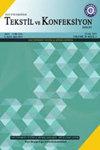Study on Fibre Reinforced Composites Developed by using Recycled Fibres from Garment Cut Waste
IF 0.7
4区 工程技术
Q4 MATERIALS SCIENCE, TEXTILES
引用次数: 0
Abstract
Garment cut wastes from apparel industries are used for various applications in various industries. Normally garment cut wastes and recycled fibres from garment cut wastes are used in textile, furniture, carpet, paper, automobile, construction, and agricultural industries in low mechanical performance applications. In this research, composites are developed by using recycled fibres obtained from garment cut wastes as reinforcement and with different types of matrices. Recycled fibres used as reinforcements are obtained from garment cut wastes of cotton, polyester and cotton/polyester fabrics to develop these composites. These composites are developed by using Epoxy resin, Kaolinite, Polypropylene sheet as matrices. Reinforcements and matrices have used in different compositions and combinations to develop these composites. The main advantages of this type of composites are to combine the different properties of different materials to obtain unique and high-performance material. Technical properties like thickness, mass per unit area, Tensile strength, Flexural strength, Impact strength, Water absorbency and Scanning Electron Microscope of developed composites were tested and analyzed. The outcome of the results demonstrates that many of the composite proportions with different blend, reinforcement and matrcies show superior mechanical performances when compare it with each other, and it can be recommended for many potential applications.利用服装废料回收纤维制备纤维增强复合材料的研究
来自服装工业的服装切割废料被用于不同行业的各种应用。通常,服装切割废料和从服装切割废料中回收的纤维被用于纺织、家具、地毯、造纸、汽车、建筑和农业等低机械性能的行业。在这项研究中,复合材料是利用从服装切割废料中获得的回收纤维作为增强材料,并加入不同类型的基体。从棉、聚酯和棉/聚酯织物的服装切割废料中获得用作增强材料的再生纤维,以开发这些复合材料。这些复合材料以环氧树脂、高岭石、聚丙烯片材为基体研制而成。增强剂和基体以不同的成分和组合来发展这些复合材料。这类复合材料的主要优点是结合不同材料的不同性能,获得独特的高性能材料。对所研制的复合材料的厚度、单位面积质量、拉伸强度、弯曲强度、冲击强度、吸水率和扫描电镜等技术性能进行了测试和分析。结果表明,不同共混、增强和基体配比的复合材料具有优异的力学性能,具有广泛的应用前景。
本文章由计算机程序翻译,如有差异,请以英文原文为准。
求助全文
约1分钟内获得全文
求助全文
来源期刊

Tekstil Ve Konfeksiyon
工程技术-材料科学:纺织
CiteScore
1.40
自引率
33.30%
发文量
41
审稿时长
>12 weeks
期刊介绍:
Tekstil ve Konfeksiyon, publishes papers on both fundamental and applied research in various branches of apparel and textile technology and allied areas such as production and properties of natural and synthetic fibers, yarns and fabrics, technical textiles, finishing applications, garment technology, analysis, testing, and quality control.
 求助内容:
求助内容: 应助结果提醒方式:
应助结果提醒方式:


